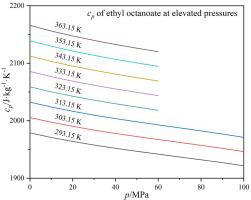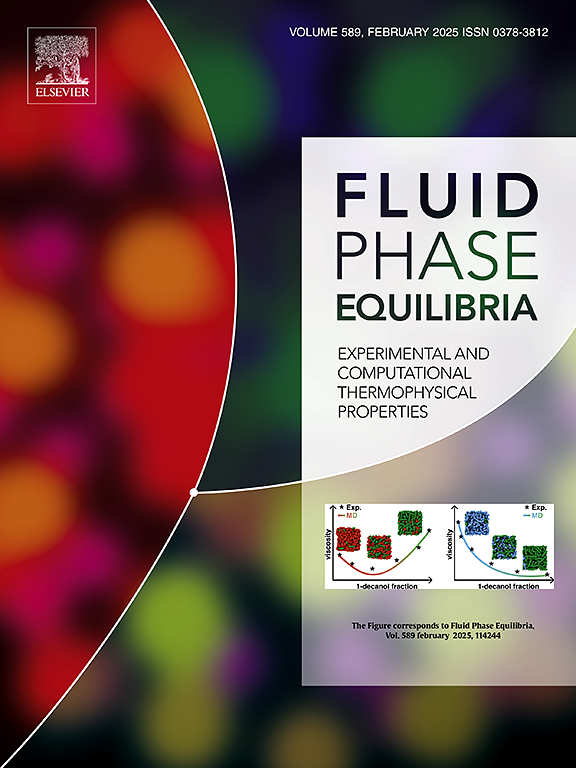辛酸乙酯在313-453 K高压下等压比热容的研究
IF 2.7
3区 工程技术
Q3 CHEMISTRY, PHYSICAL
引用次数: 0
摘要
本研究利用流动量热法测定了辛酸乙酯在313.15 ~ 453.15 K压力下的等压比热容,测量不确定度为0.095。与文献数据的偏差在0.1 MPa和升高压力下分别为0.43%和0.42%。通过整合文献资料,对辛酸乙酯的计算方程进行回归,偏差≤0.42%。利用微分关系(∂cp/∂p)T=−T(∂2v/∂T2)p,建立了等压比热容预测模型。该模型将热容的预测范围扩展到100 MPa,在实验范围内的平均绝对偏差(AAD)为0.28%,具有满意的精度。本文章由计算机程序翻译,如有差异,请以英文原文为准。

Study on isobaric specific heat capacity of ethyl octanoate under high pressure across 313-453 K
This study experimentally determined the isobaric specific heat capacity of ethyl octanoate using flow calorimetry across 313.15 to 453.15 K at pressures up to 10 MPa, with measurement uncertainty of 0.095. Deviations from literature data were within 0.43 % at 0.1 MPa and 0.42 % under elevated pressures. By integrating literature data, a computational equation for ethyl octanoate was regressed, exhibiting deviations ≤0.42 %. Utilizing the differential relationship , a predictive model for isobaric specific heat capacity was established. This model extends the prediction of heat capacity to 100 MPa, achieving an average absolute deviation (AAD) of 0.28 % within the experimental range, demonstrating satisfactory accuracy.
求助全文
通过发布文献求助,成功后即可免费获取论文全文。
去求助
来源期刊

Fluid Phase Equilibria
工程技术-工程:化工
CiteScore
5.30
自引率
15.40%
发文量
223
审稿时长
53 days
期刊介绍:
Fluid Phase Equilibria publishes high-quality papers dealing with experimental, theoretical, and applied research related to equilibrium and transport properties of fluids, solids, and interfaces. Subjects of interest include physical/phase and chemical equilibria; equilibrium and nonequilibrium thermophysical properties; fundamental thermodynamic relations; and stability. The systems central to the journal include pure substances and mixtures of organic and inorganic materials, including polymers, biochemicals, and surfactants with sufficient characterization of composition and purity for the results to be reproduced. Alloys are of interest only when thermodynamic studies are included, purely material studies will not be considered. In all cases, authors are expected to provide physical or chemical interpretations of the results.
Experimental research can include measurements under all conditions of temperature, pressure, and composition, including critical and supercritical. Measurements are to be associated with systems and conditions of fundamental or applied interest, and may not be only a collection of routine data, such as physical property or solubility measurements at limited pressures and temperatures close to ambient, or surfactant studies focussed strictly on micellisation or micelle structure. Papers reporting common data must be accompanied by new physical insights and/or contemporary or new theory or techniques.
 求助内容:
求助内容: 应助结果提醒方式:
应助结果提醒方式:


